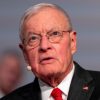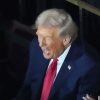Credit: AP
The first thing you notice about Donald Trump in the flesh is his size. He has a rugby player build: 6ft 3in and 17 stone.
His sheer physicality is never quite captured on television. Neatly cut suits hide his bulk from the camera, but in person — especially side-on — it is unavoidable.
The second thing is the hair, swept across and back and fixed in place. It is like a crashing wave frozen in motion.
And then there is the skin complexion. A warm, yellow hue that draws your eyes after all the speculation about sunbed use.
At least, that is the order I remember when seeing him first after moving to Washington DC as The Telegraph’s US Editor in October 2017.
After years covering Westminster, I had been sent to try to unpack the Trump phenomenon to British readers, the nature of his appeal and how he was wielding power.
For the next three years and four months my working life revolved almost entirely around the president — his moods, his decisions, his controversies, his tweets.
There were rallies across America, where he was welcomed like a saviour. There were foreign trips to Hanoi, Singapore, Brussels, Helsinki and London, where he was treated with caution.
Most of the time you simply felt swept along by an unrelenting current of news, much of it directed by Mr Trump himself, a master media manipulator.
With his tenure now in the rear-view mirror and my own time in the US capital drawing to a close, it is perhaps worth a look back on what took place and what it revealed.
For spending so much time focused on a single person brings a kind of clarity. In this case, it leaves a sense of foreboding, too, over the depth of the fractures in America it exposed.
Unpicking the Trump enigma
Within a few weeks of arriving it was clear my preconceptions of the Trump presidency, then nine months old, needed to be reassessed.
Following from afar in Britain, a neat portrait had been painted by television and radio news packages: of a man who fluked his way into office with Russian help, was blundering through the White House and was doomed to election defeat.
That narrative, comforting to a UK public deeply sceptical of Mr Trump, never quite held true. For one, it portrayed his presidency as something done to America, not created from it.
The depth of Mr Trump’s support in whole swathes of the country — especially rural, white, southern parts — was real. It would hold for years and still remains true today.
Where many Britons recoiled at the clumsy implementation of controversial policies and total disregard for the norms of the job, Trump voters cheered. They sent him to Washington to break noses and took the squeals of the DC establishment as proof it was being done.
Nor did Trump supporters fit the stereotype. In Texas, a young woman described fears her Latin American partner would be deported as he did not have legal papers to stay. Then she said they had both voted for Mr Trump, given their Christianity and his anti-abortion stance.
In Pennsylvania, an owner of a street lighting company described how his grandfather and father — who ran the business before him — were dyed-in-the-wool Democrats. Yet he was all-in for Mr Trump, seeing something heroic in his battle to bring back industrial jobs.
In Iowa, a soybean farmer with a limp showed me round his plot — after insisting on serving up a roast for lunch — and admitted fears of bankruptcy from the plunging soybean price. He knew Mr Trump’s China tariff war was the cause but supported him nonetheless, believing Beijing had got away with it for too long.
The most common question asked by Britons to DC reporters is to unpack that appeal. What is it Trump supporters see in him? How has he forged such a deep and powerful bond? Even after spending so long trying to answer just that I cannot claim to understand it fully, but pieces of the puzzle are visible.
Clearly his business outsider status was a huge aspect — the thing mentioned most frequently by the Trump faithful. Mr Trump had become the embodiment of American corporate success. It was less his riches — many surpassed him there — but the business whizz image he had projected for decades and which became hard-wired into the US conscience via The Apprentice.
Many voters saw in his sharp suit, model wife, and private jet branded with his own name not brash extravagance but the American dream achieved. There is a reason Mr Trump was name-dropped in dozens of rap songs.
Many voters saw in Donald Trump's sharp suit, model wife, and private jet branded with his own name not brash extravagance but the American dream achieved — see for example his star turn in Home Alone 2 in 1992
Beyond the ‘America’s CEO’ appeal there were other powerful forces. His nativism connected with those who saw immigration threatening their way of life. His trade wars were cheered by those stripped of jobs and status by globalisation.
His unrefined speaking style, so mocked inside the Beltway, made him relatable. His anti-war impulse was shared by most in a country tired of Middle East intervention. His disregard for presidential norms was cheered by those sick of the status quo.
Added into the mix were Mr Trump’s rare political attributes. He was a gut instinct politician with a unique ability to sense what the Republican base wanted.
There is a telling part in a book written by two top lieutenants of his 2016 campaign, Corey Lewandowski and David Bossie, about how the infamous border wall pledge came about.
The men recount how, in essence, they floated the idea as a way to get him to talk about immigration. He baulked at first, then used it. The crowd went wild. So he kept on using it, making additions — Mexico can pay! — as he went along.
A natural in the spotlight
Mr Trump’s ease in the spotlight was another critical feature. His 2018 speech at Cpac, the country’s leading conservative political conference held annually in a cavernous venue near Washington, was a reminder of that. Most leading Republicans spoke and they all tried the same shtick: Toss red meat to the base, keep them cheering and remind them you are one of them.
Mr Trump blew the others out of the water. In the first few minutes he turned to look at the big screens behind projecting his image, pretending to fix his hair as if it was a mirror.
There was a script on the teleprompter but it was barely used. Instead, for an hour Mr Trump ad-libbed and wandered off in verbal tangents. This was a performance — all political speeches are — but one that was off-the-cuff.
As he always did before a crowd of supporters, Mr Trump, bathing in their adoration, trusted his mind to find fertile political grounds, however controversial. He had them eating out of the palm of his hand.
It was similar when answering questions. Every politician I have ever covered has a filter through which reporter questions are screened. There is a pause as political calculations are made, then a response normally framed carefully and caveated. With Mr Trump, there is no filter. The words just come tumbling out.
The Trump Card, with Nigel Farage — Episode one — The Man
Just before the 2018 midterms someone asked Mr Trump if he would sack Jeff Sessions, his beleaguered attorney general, after the election. The ‘warning, unhelpful news trap’ sign should have lit up.
Instead, Mr Trump happily made clear that yes, he probably would. The campaign’s final days were dominated by more Washington chaos looming, not the economic wins of his first two years.
He lost the House of Representatives. He then sacked Mr Sessions. It was that candour, endlessly on show, that his supporters relished.
Penetrating the inner circle
The cast of characters around Mr Trump was just as colourful. Many saw him as a vessel for self-advancement: either for their beliefs, career, ego or wallets.
Truth be told, journalists for British media outlets cannot penetrate a president’s inner circle in the way top US reporters can. Politics is transactional. Politicians in the main answer calls from reporters because their readers are voters. There are not many US votes in Britain.
Yet the nature of the Trump presidency, with its bunch of outsiders now on the inside and an ever-spinning revolving door, meant there were routes in.
Steve Bannon could be got to. His grand townhouse was on Capitol Hill, near both the Supreme Court and the offices of congressmen he was attempting to primary. It was in the heart of the DC establishment he professed to loath.
The times I visited, his relationship with the president — whose campaign he once led and thinking he shaped as White House chief strategist — had eroded. Later it would come full circle, Mr Trump pardoning him as one of his final acts in office.
We talked in his dusty, dark first-floor sitting room, where the ceiling was high and a single copy of a book recently published about him was placed on the mantelpiece.
Or rather, he talked, a rapid monologue of assertions and predictions delivered as fact. Some proved true: that if the Democrats won the House they would inevitably impeach. Others, less so: that Mr Trump, bored of office, would not seek re-election in 2020.
Kellyanne Conway, Mr Trump’s former campaign manager and senior White House adviser, was another who agreed to talk, though only after dozens of calls and emails over months. Winding corridors led to her West Wing office, the same Hillary Clinton once used. “I can get to the Oval Office in twelve seconds in three inch heels,” she said, knowing access is power.
The conversation was routine until near the end, when — holding back the trickier questions in case she stormed out — I asked if she regretted once talking about “alternative facts”. “I’m surprised someone who calls themselves a reporter would go back in time,” she said, delivering a heated dressing-down.
Trying to lower the temperature, I said the question had not been an attempt to rile her. “No, you didn’t rile me at all,” she shot back, adding: “How in the world would you rile me? You’re visiting me in my White House office. I’ll be here every day until I decide not to be.” There was no handshake once ushered to the door.
Scrambled into a bunker
It was in the second half of Mr Trump’s term that things began to spiral. Gone was control of the House and with it hopes of passing legislation without Democratic votes. Approaching was the election. There was also a torrent of crises.
One was common across the world: Covid-19. It was the defining challenge of Mr Trump’s presidency and one the voters ultimately concluded he failed. Erraticism is not a characteristic most valued in times of life and death.
Another erupted from within: the anti-racism protests in the spring of 2020 after George Floyd’s death while being restrained by police. It was surreal watching protesters and police officers grappling outside the White House the first night the violence reached DC.
Law enforcement had been caught on the hop. A single line of officers stood between the seething protesters and the White House fence. Somewhere inside Mr Trump was scrambled into a bunker. The crowds were only cleared around 3am by pepper spray.
Things escalated from there, each day the crowds getting bigger, the law enforcement presence more ominous. Curfews were called, flash bangs used. I was there when the crowd was forced back for Mr Trump’s bible-holding photo-op, scrambling in retreat as the line advanced.
Being issued with protective headgear, goggles and a bright yellow press vest was not usual for the DC beat. Nor was witnessing a city patrolled by soldiers, hovered over by military helicopters and sectioned by 7ft fences. It would not be the last time that it happened.
And then there were the crises of Mr Trump’s own making. His single term saw half of all the presidential impeachments in American history, that is two of four. Both revolved around his obsession with election victory.
The first came after he held back hundreds of millions of dollars in military aid while pushing Ukraine to investigate the presidential rival he feared most, Joe Biden, and his son. The second was over the deadly Capitol riot by supporters parroting his false claims of victory.
Having sat in the House of Representatives for both votes, with congressmen peering up at the electronic board beamed above the reporters’ gallery as the ayes and nays were logged, the mood was different in each.
For the first impeachment in December 2019, Republicans were defiant and full square behind the president. Impeachment — they argued — was a political hit job, a shameless attempt by Democrats to oust their leader. Not a single Republican in the House voted for the move.
The second, earlier this month, was different. There was universal condemnation for the event that brought them to that moment: an attack on the home of US democracy in Mr Trump’s name that had left five dead.
Ten Republicans voted to impeach. Even as the vast majority of Republicans opposed the move, few spoke up for Mr Trump in the debate. Something had changed.
Reminders of that day of violence on Jan 6 are still everywhere in Washington. Chain fences carve up the city, though some are coming down. Camouflaged soldiers with guns are still dotted in huddles, staring blankly, though the sight is more rare.
Mr Biden, now President Biden, has tried to make a merit of what the country has been through. “This is democracy’s day”, he said in the opening lines of his inauguration speech, framing his victory as a national triumph.
It is an argument heard a lot: that Mr Trump’s failure to overturn the election result and his norm-shattering presidency actually proves the strength of America’s democratic institutions. The storm has been weathered and they remain intact.
Perhaps. But when I look back it is the weaknesses that stand out. The ease with which trust in the press can be eroded from the top. The speed with which mistruths can become fact for millions. The incentives to keep a congressman silent if their leader holds the base. Above all, the realisation that for democracy to function the loser has to accept the loss.
Biden comes to office with a slightly less partisan division than Trump — but far more than Obama
Critics of Mr Trump should pause before declaring total victory. Three quarters of Republican voters think Mr Biden’s win is illegitimate. Eleven million more Americans voted for Mr Trump in 2020 than 2016. After a once-in-a-century pandemic and brutal economic crash he still came close to victory.
Even if he fades from view, the fragilities in the democratic system he exposed will not just disappear. In fact the opposite. There is a blueprint now. Scores of Republicans will try to replicate at least parts of it to win the party’s 2024 presidential nomination.
During his rallies, those centres of energy that fuelled his rise, Mr Trump would like to say a single phrase at the close: “The best is yet to come.”
I wish I could say the same as America attempts to patch up its democracy, but in truth I fear the opposite.






















































Свежие комментарии